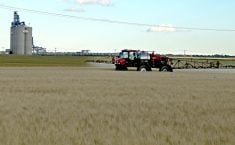Higher commodity prices will increase the amount of money that is available this year through the federal program
The expectation of strong cash values for almost all farm commodities in 2022 will have a significant impact on the amount of credit offered this year through the Advance Payment Program, says the program’s largest administrator.
Dave Gallant, director of finance and operations at the Canadian Canola Growers Association, said the average value of APP cash advances offered through the CCGA’s cash advance program will increase significantly this year, based on higher projected values for crops and livestock.
“The (APP eligibility) rates for all farm commodities have increased dramatically this year,” Gallant said.
Read Also

New coal mine proposal met with old concerns
A smaller version of the previously rejected Grassy Mountain coal mine project in Crowsnest Pass is back on the table, and the Livingstone Landowners Group continues to voice concerns about the environmental risks.
“What that means for farmers is that there is a lot more cash flow available through the cash advance program this year, even if the operation is exactly the same size as last year … and (it grows) the same products and the same quantities as last year.”
“We expect to see the average cash advance jump significantly this year because of that and I would expect that this might inspire more farmers to look at the program more seriously….”
Maximum loan amounts for APP cash advances are based on several factors.
One key factor is average projected commodity prices during the calendar year, as determined by Agriculture Canada.
Federally adjusted APP rates for 55 different agricultural commodities were shared with APP program administrators earlier this month.
The rates reflect the expectation of strong demand and high prices for cereals, pulses, oilseeds, livestock and other eligible commodities.
Each year, thousands of farmers use CCGA’s cash advance program to finance their spring input purchases.
The program offers low-interest rates on short-term loans of up to $1 million.
Farmers who qualify for a maximum $1 million loan receive the first $100,000 on an interest-free basis. The remaining $900,000 is repayable with interest, over terms of 18 to 24 months.
The CCGA is one of several APP program administrators in Western Canada. Other organizations also offer cash advance loans under the federally backed APP program.
A complete list of program administrators and interest rates offered can be viewed online here.
This year’s APP eligibility rates, as determined by the federal government, are up sharply from 2021, although the rates are still well below the actual market value of crops that are used as loan collateral.
The APP eligibility rate for western Canadian canola, for example, is estimated at $363.75 per tonne this year compared to $252.20 in 2021, a year-over-year increase of nearly 31 percent.
Eligibility rates for durum are up 40 percent to $194 a tonne in 2022, the rate for lentils is up 50 percent to $363.75 a tonne, and the rate for Saskatchewan feed barley is up 15.4 percent to $126.10 per tonne.
A complete list of federally calculated cash advance rates can be viewed online here.
Gallant said the higher rates will translate into a larger APP loan portfolio in 2022 and a significant increase in the size of loans available to each individual producer.
The CCGA is the largest APP program administrator in Canada. In 2019, it furnished cash advances valued at roughly $2 billion.
The average size of CCGA’s annual cash advance portfolio is between $1.5 and $1.6 billion a year, Gallant said.
In 2021, the average cash advance offered through the CCGA was around $189,000 but Gallant thinks that amount could be significantly higher in 2022, based on strong commodity prices.
“A lot’s going to depend in the growing season … but everything points to (us lending) easily 25 to 30 percent more than last year.”
The CCGA is encouraging interested farmers and ranchers to apply early this spring.
The association announced Feb. 9 that it will begin accepting applications immediately during the early application phase, which runs until March 31.
In a news release, Gallant said the CCGA had two overriding priorities when preparing to launch the 2022 application process.
“Farmers told us they want to apply as early as possible, and they want to do it as quickly as possible. We listened and have facilitated a number of improvements this year.”
“This is the earliest we’ve ever started the pre-application process …,” he added later.
“We went live shortly after the rates were available from the federal government.”
The CCGA’s interest rate for cash advance loans is a floating rate set at CIBC prime minus 0.75 percent. CIBC’s prime rate as of Feb. 10 was set at 2.45 percent, putting CCGA’s rate at 1.7 percent.
According to many financial analysts, prime rates offered by Canada’s commercial lenders are expected to go up by as much as 1.25 percent over the next 12 months, in step with the overnight lending rates at the Bank of Canada.
If those projections prove accurate, CCGA’s cash advance rate could increase to 2.95 percent before the end of the year.
Gallant said more cash advances than usual were repaid last year with crop insurance payouts — the result of poor yields caused by persistent drought conditions.
That suggests available cash flow will be tight on a larger number of farms this year, which will likely result in increased demand for cash advance loans this spring.
“It could be a very significant program this year,” Gallant said.


















